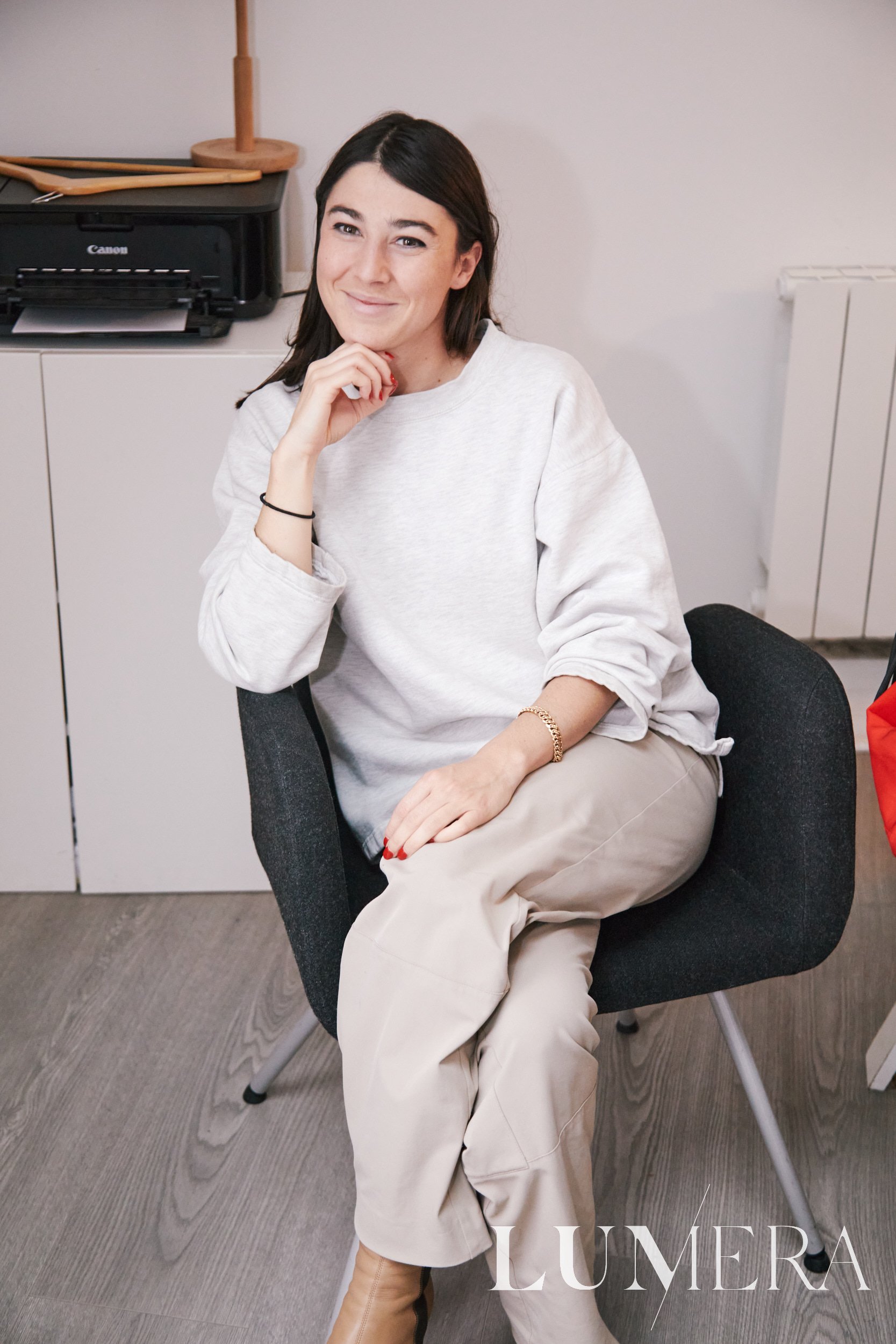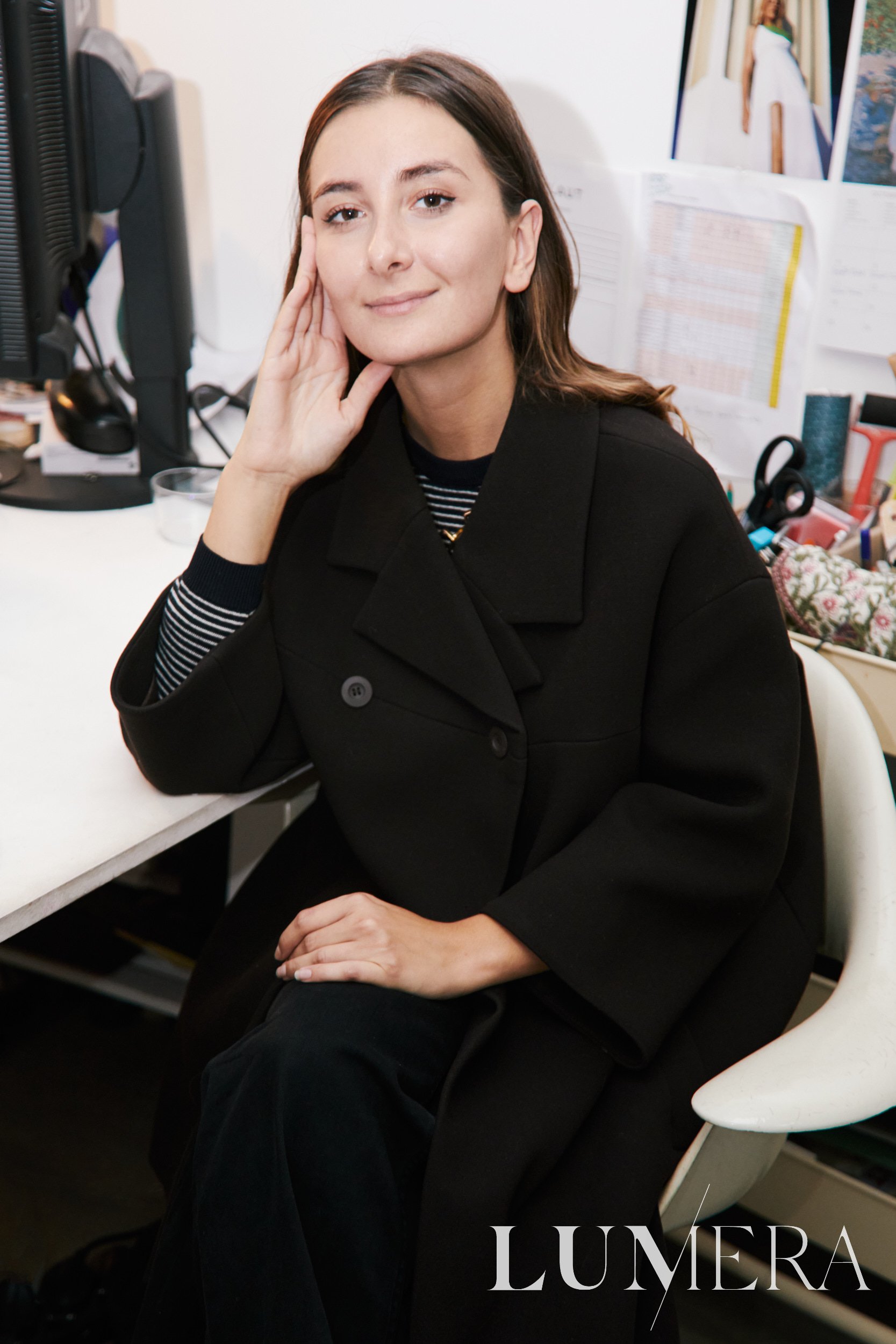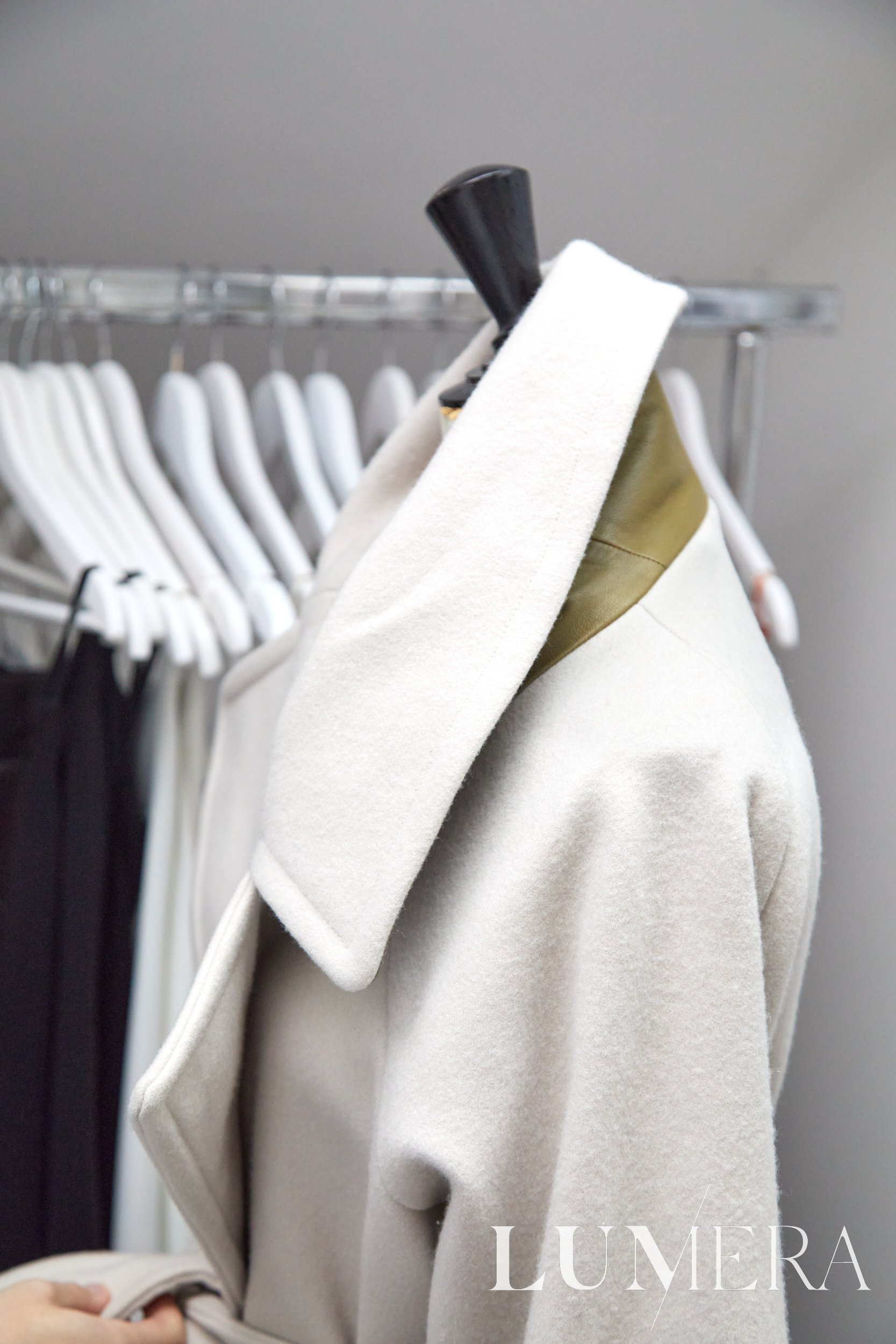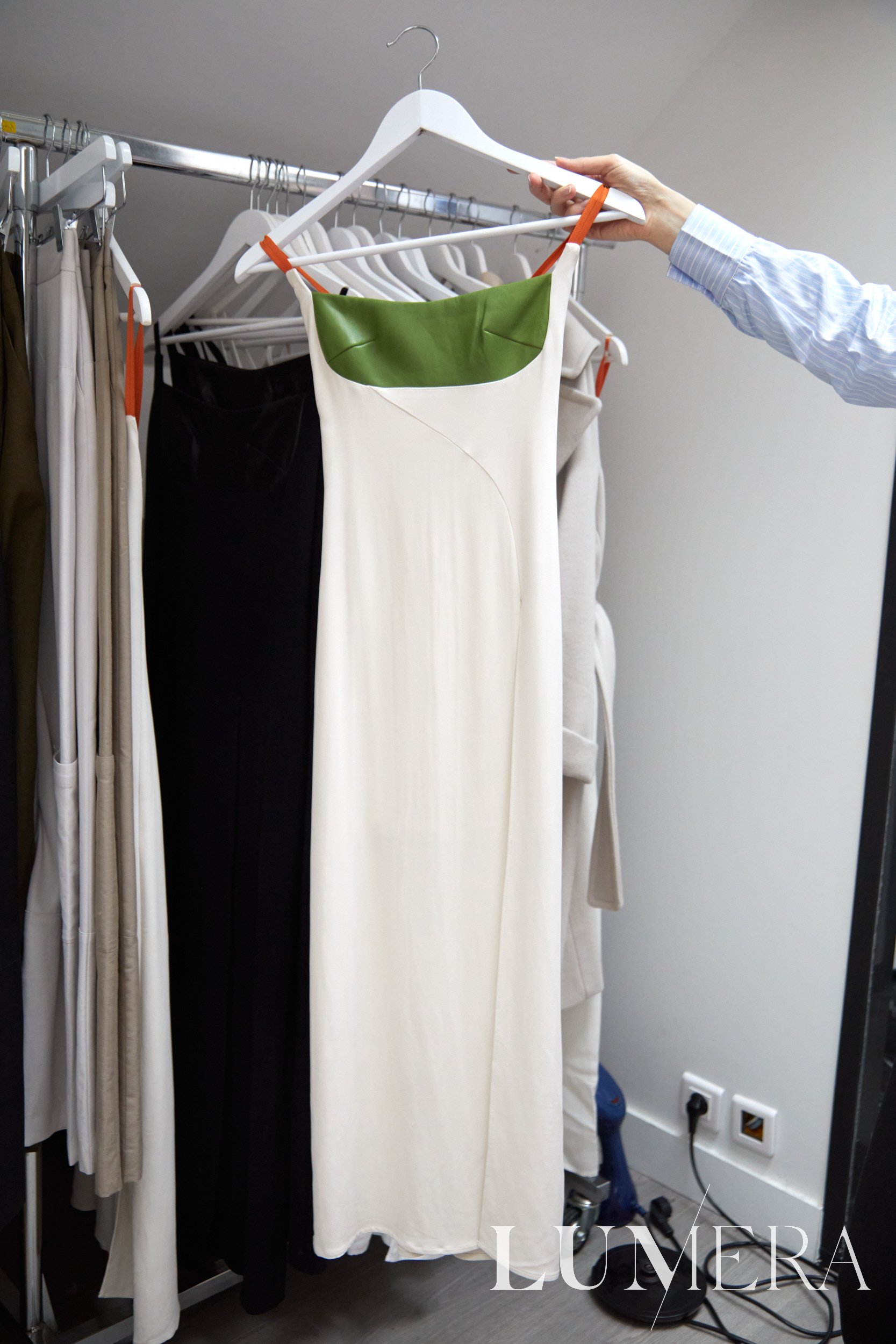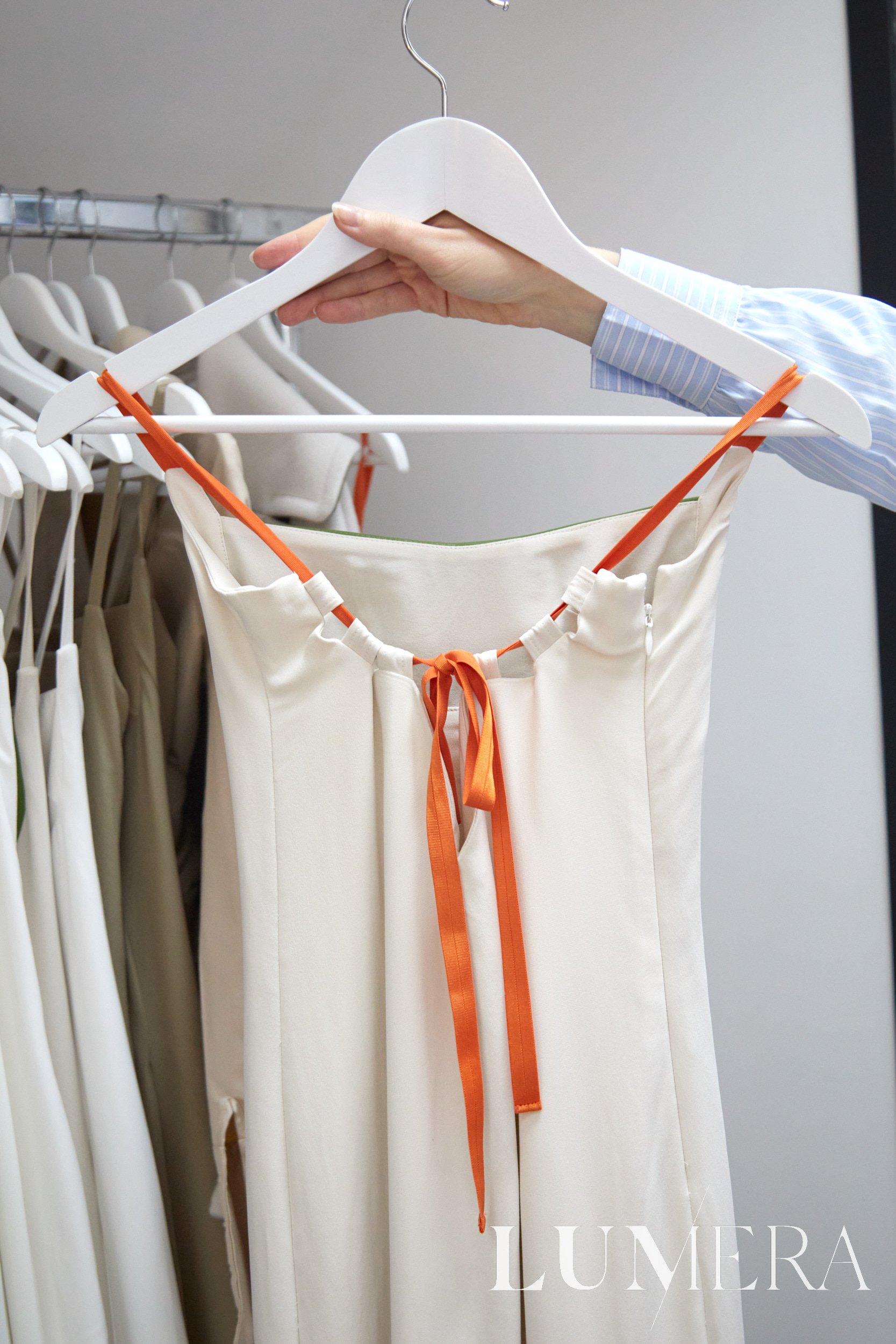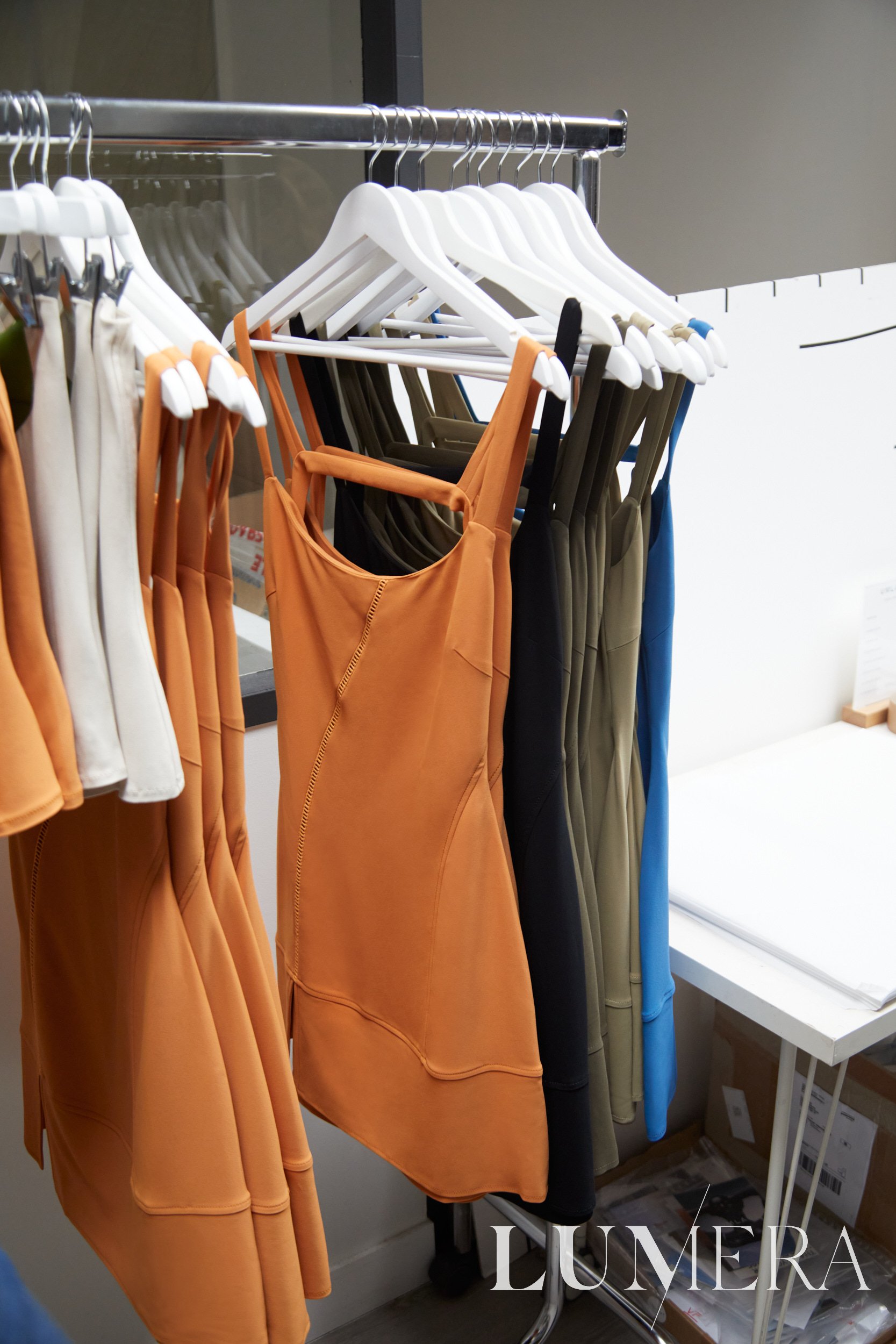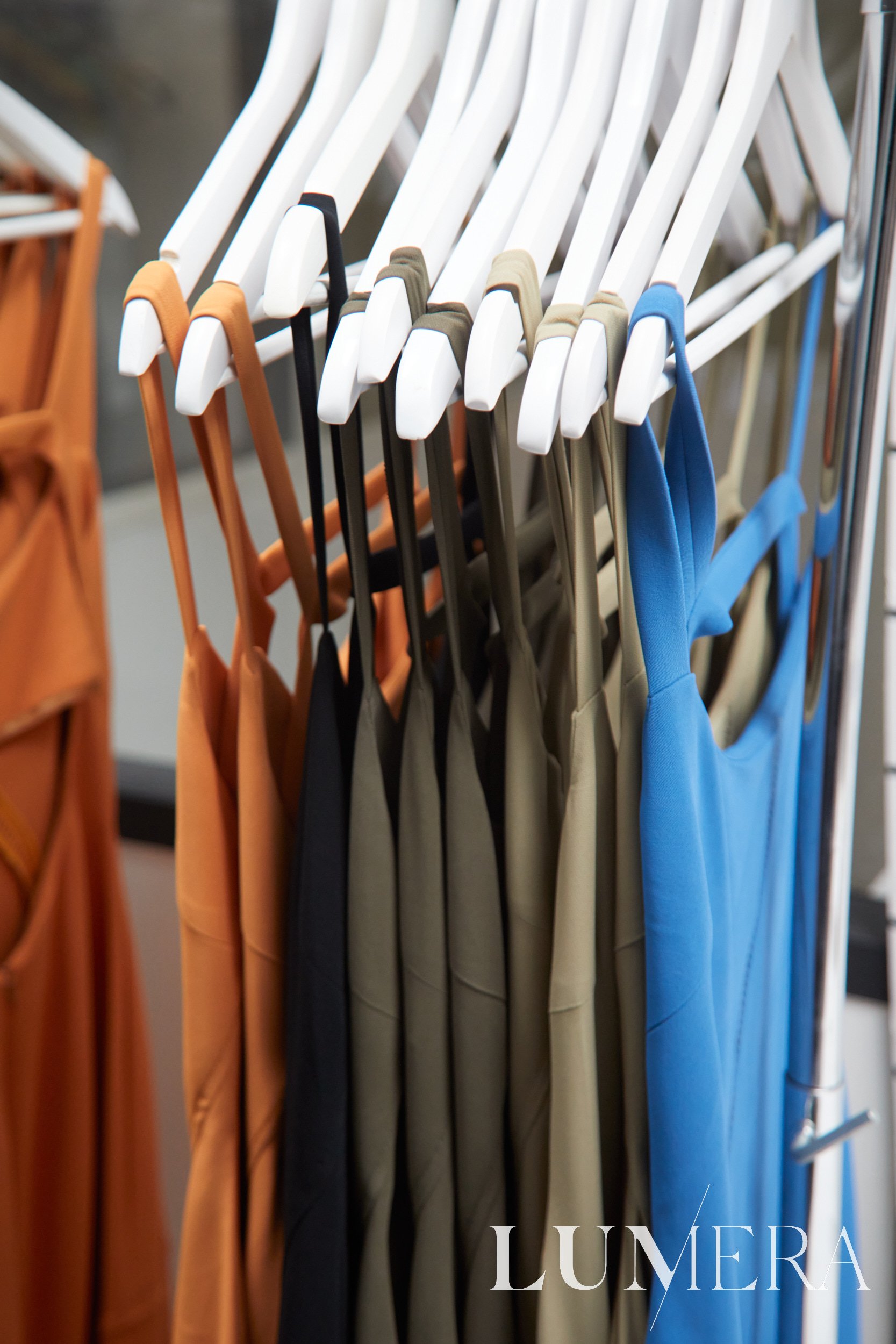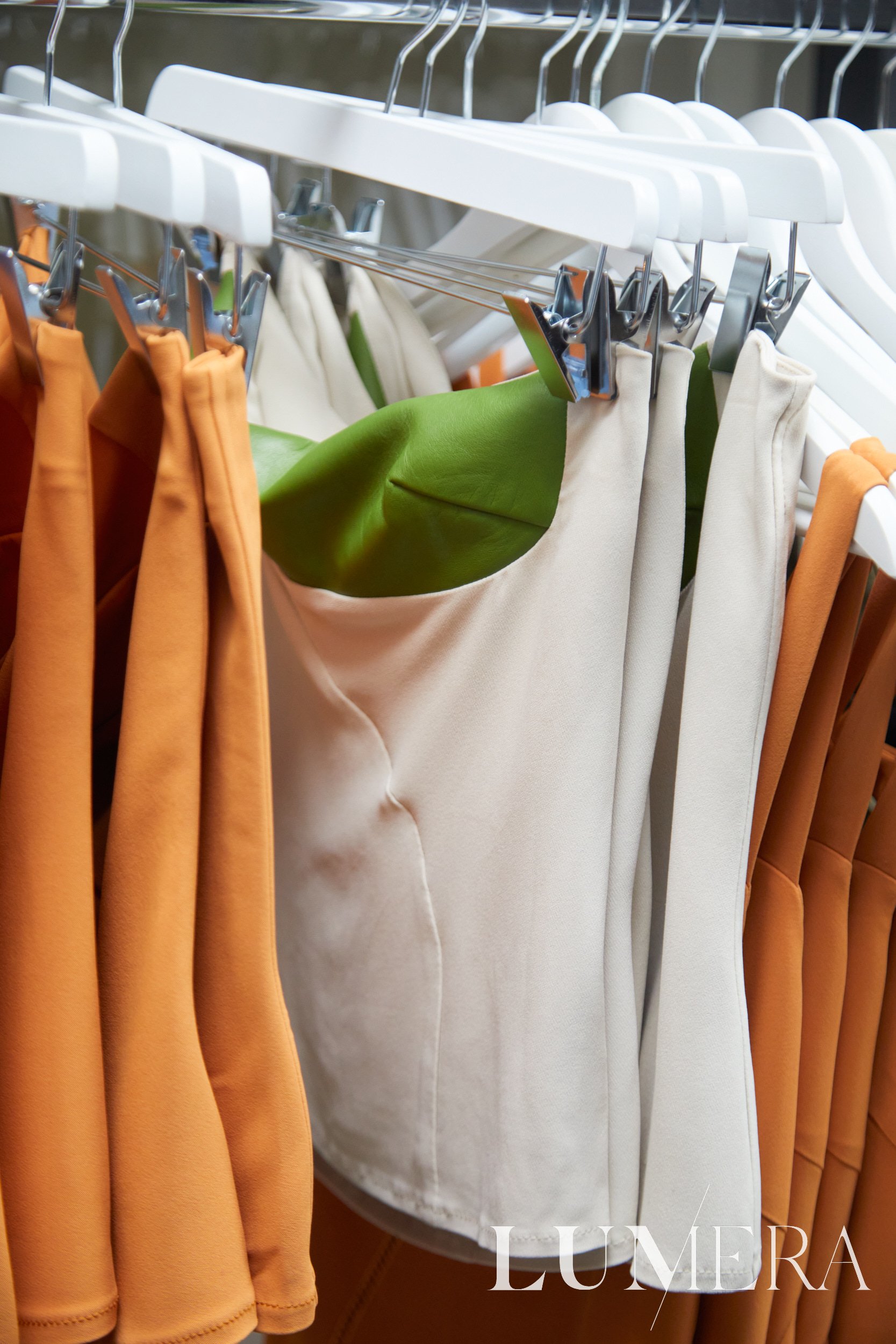
THE PARISIAN FASHION BRAND UMLAUT – THAT’S ELOISE BOMBEAU, ZELIE ISRAEL AND EMMA PANCHOT. THE THREE OF THEM KNOW EACH OTHER SINCE CHILDHOOD AND DECIDED TWO YEARS AGO THAT THEY WANT TO CONTRIBUTE TO CHANGING THE FASHION INDUSTRY. HENCE THE NAME – UMLAUT. IT IS THE GERMAN PHONETIC SYMBOL THAT MODIFIES A VOWEL FROM AN A TO Ä OR A U TO Ü. LIKE THE UMLAUT ON LETTERS, THE GIRLS CHANGE THE SUPPLY CHAIN IN THE FASHION INDUSTRY. HOW? FIND OUT IN OUR INTERVIEW, ANDREW AND I VISITED THEM IN THEIR STUDIO IN THE 10TH ARRONDISSEMENT. THEIR OFFICE IS ON THE TOP FLOOR OF A SHARED WORKSPACE BUILDING FOR ARTISTS. VARIOUS CREATIVES BOOK STUDIOS HERE AND SUPPORT EACH OTHER WHERE THEY CAN. ONCE WE MADE IT TO THE THIRD FLOOR, WE WERE WELCOMED BY RACKS OF THE POPULAR UMLAUT DRESSES, TOPS AND PANTS, ALL ORGANIZED BY COLOR. THEIR CAMPAIGNS DECORATE THE WALLS AND ON THE OTHER SIDE OF THE HALL WAS ANOTHER YOUNG BRAND IN THE MIDDLE OF A PHOTO SHOOT.
words by SARAH MARIE FRANKEN photographs by ANDREW DAY
https://lumeramag.com/small-brands/umlaut-three-friends-reviving-leftover-haute-couture-fabrics
YOU CHOSE THE NAME UMLAUT BECAUSE YOU WANT TO CHANGE THE FASHION INDUSTRY. WHAT IS YOUR IDEAL VISION FOR THE FUTURE OF FASHION?
Emma: As a first step within the next few years, it would be an increased use of upcycling. There are a lot of fabrics that are made but never used. And as a second step there is the subject of fabric innovation. How can we create more fabrics that are ecologically made? It would be nice to create some new materials with innovation and engineering!
I LOVE THAT, INNOVATION AND USING WHAT WE ALREADY HAVE. AND THAT IS EXACTLY WHAT YOU DO WITH YOUR BRAND. DO YOU FOCUS EXCLUSIVELY ON UPCYCLING HAUTE COUTURE FABRICS OR INCLUDE LEFTOVER FABRICS IN GENERAL?
Eloise: I think for 90% it is fabrics from the biggest luxury houses in Paris like Givenchy, Louis Vuitton or Sonia Rykiel.
Emma: But they don’t produce the fabrics, they get their fabrics from mainly Japanese or Italian manufacturers.

EXACTLY, AND THEN WHAT HAPPENS IS THAT THEY BRING WHAT THEY DON’T USE TO STORES WHERE YOU PURCHASE THEM FROM?
Eloise: Correct, we get them either from stores, associations that auction them or start-ups.
Emma: A few weeks ago for example we started to work with a start-up. It’s a guy who worked with LVMH for many years and now he is building this incredible start-up, where he collects the fabrics from all the LVMH brands that are not being used. And he sells them for fair prices to small brands like us who don’t have a big budget. It’s great. There are actually quite a few start-ups who are doing that now.
WHAT IS THE BUYING PROCESS LIKE FOR YOU? WHERE DO YOU GO PHYSICALLY?
Eloise: (laughs) we go everywhere! We have to source a lot of fabrics, like you can see. These are all the fabrics that we sourced for our new production. We need to have a big stock because we can’t choose the exact color of the fabrics, everything is already made. So, we need to have a big stock of different options. We really go to a lot of places to find fabrics. Often it feels like finding the needle in the haystack.
Emma: It is funny because we always meet some new people or discover new places that sell leftover fabrics. It is a really fun process to source them!
“WE NEED TO HAVE A BIG STOCK OF DIFFERENT OPTIONS. WE REALLY GO TO A LOT OF PLACES TO FIND FABRICS. OFTEN IT FEELS LIKE FINDING THE NEEDLE IN THE HAYSTACK.”
Eloise Bombeau
I CAN IMAGINE! AND FOR THE FABRIC HUNT, DO YOU GUYS GO ALL TOGETHER AND MAKE A DAY OF IT?
Eloise: Yes! We call it our sourcing days! We go to various arrondissements in Paris all together and look for this very specific jersey or a certain color of silk. It’s the mission of the day to find exactly that.
IN WHICH ARRONDISSEMENT DO YOU FIND THE MOST?
Often in the 3rd arrondissement, sometimes in the suburbs, or in the 10th – it changes all the time.
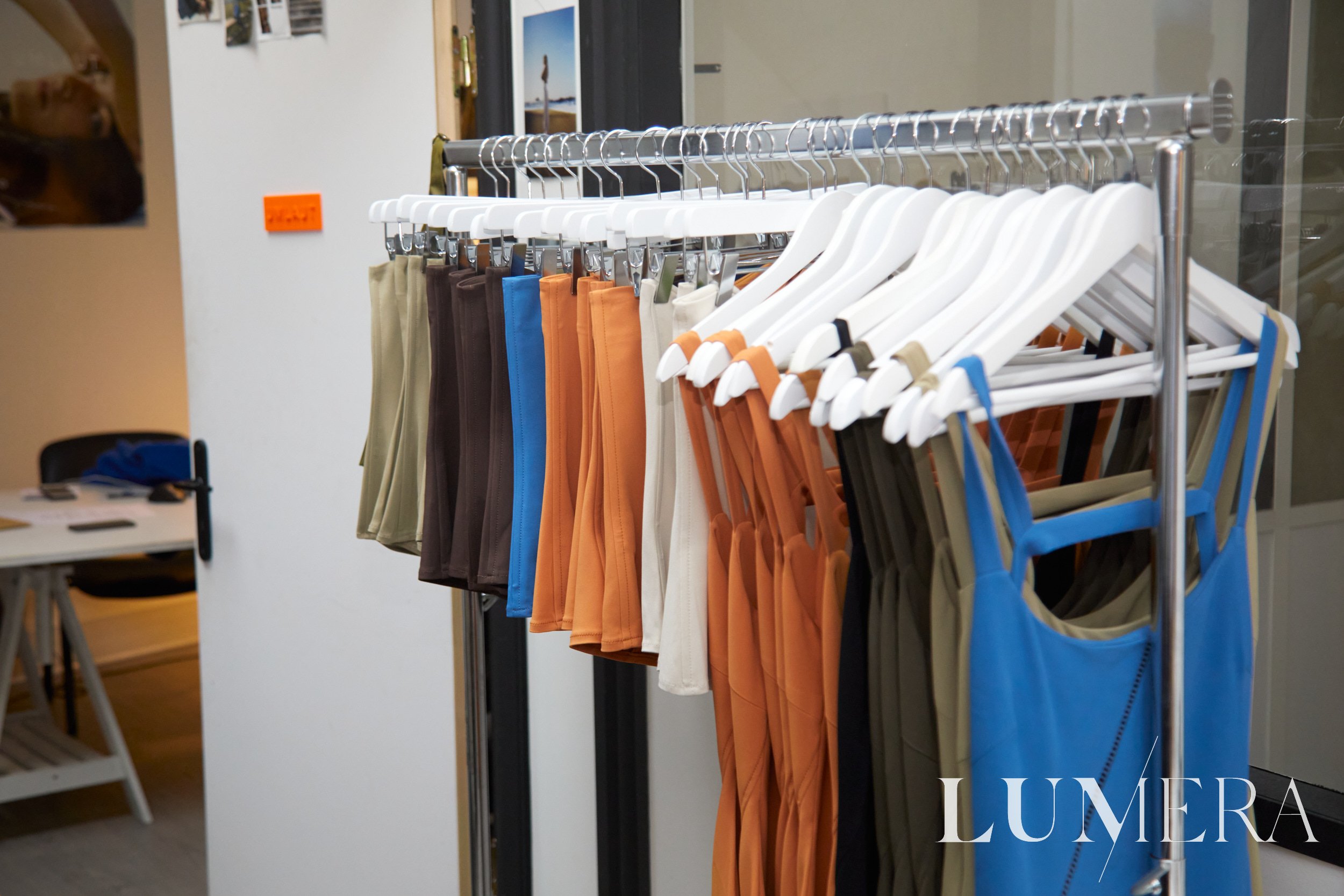
AND I READ THAT YOU ALSO GO TO FLEA MARKETS!
Eloise: We did a lot in the beginning! For the new pieces we do it less. When we go it’s to this great flea market in Biarritz, in the south of France. We managed to find some beautiful silk with beautiful patterns there!
Emma: But it was really at the beginning, because you can only find small quantities, 3 meters maximum! And with that, we can make only one dress. So now that’s not possible anymore (laughs). Unfortunately, we need more!
HOW DO YOU FIND OUT ABOUT THE START-UPS? DO YOU FIND THEM ONLINE?
Emma: It’s more mouth-to-mouth. It’s either people talking about us or we talking to people about what we are looking for. It’s more within the contacts we have in Paris.
HOW DID YOU GET THE IDEA ABOUT UPCYCLING WHEN STARTING YOUR BRAND. I KNOW SOME OF YOU GUYS WORKED FOR ESTABLISHED FASHION BRANDS, DID THAT EXPERIENCE CONTRIBUTE?
Eloise: Zelie and I studied fashion design at Atelier Chardon Savard in Paris. And within that we did internships at different maisons. Zelie went to Jaquemus and Paco Rabbane and we both went to Louis Vuitton. Both of us noticed that they had a lot of fabrics that they didn’t use at all. They would even trash them, cut them to pieces or burn them. Sometimes they give them to fashion schools, but it’s never all the stock they have. I think this was the time when we realized the problem and that something needs to be done about it. Those fabrics are amazing, the quality, the colors! It’s such a waste. We knew we needed to do something. And Emma is very passionate about fashion, photography and visual communication. We are three best friends, we all work in fashion and we want to contribute to a change in the industry! We needed to do something! And we are young, we were 24 when we had that idea.
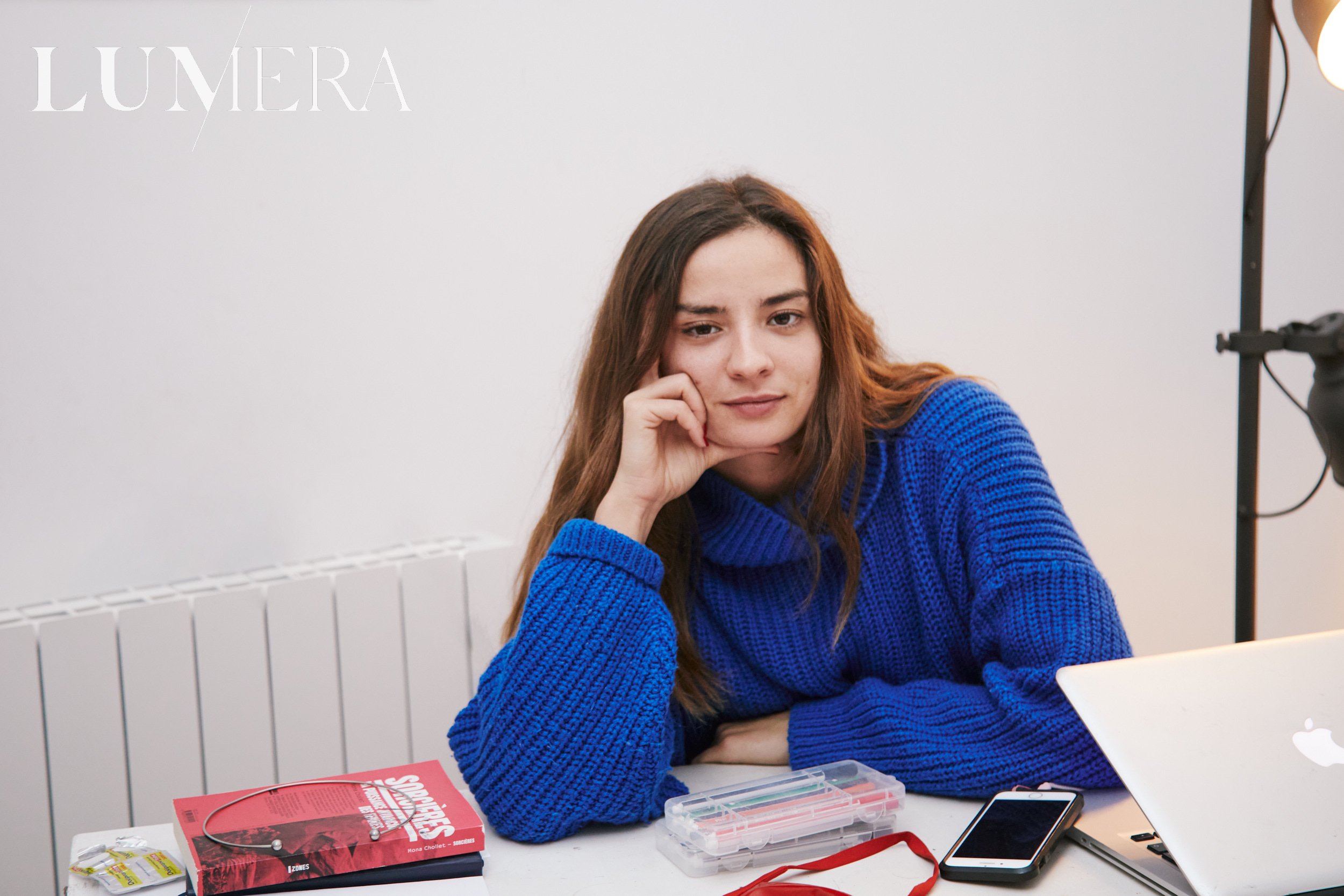
Clockwise from top left: Zelie Israel, Eloise Bombeau, Emma Panchot
AMAZING! AND DID YOU HAVE A SPECIAL MOMENT OVER A GLASS OF WINE WHEN YOU DECIDED TO DO SOMETHING ABOUT THIS?
Eloise: (laughs) It happened over a lot of glasses!
Emma: (laughs) oh la, yeah! At the beginning, Zelie and Eloise wanted to start a brand together, just the two of them. I was studying in Switzerland. I wanted to work in art direction or photography and am very passionate about the fashion industry. Especially the communication side of it. I had this moment when I felt a bit lost in my studies and didn’t know what to do with my life. I thought to myself that I want to create something, a studio, a brand, I didn’t know, but I was certain that I want to create my own thing. And I knew that the girls were already planning the brand together. And one day I just came to them and told them I wanted to join them. I called Eloise, she was in Bucharest at that time.
Eloise: I remember, we were so excited! Until then our brand was something we planned for some time in the future. We didn’t know if it would be in 2 years, 5 years. So when Emma called us and told us she wants to do something all together – it was great!
Emma: One night we were just writing stuff down, brainstorming ideas, trying to understand what we wanted, what we liked. The girls were at university together, but I was in Switzerland for four years and learned something completely different. To understand what we all like and don’t like was a lot of discussion at the beginning. We needed to find out what we want the brand to look like.
Eloise: And we really learned from each other. Emma shared her experience from her studies in Switzerland, and Zelie and me shared ours from our university in Paris. It was a big exchange!
“I THOUGHT TO MYSELF THAT I WANT TO CREATE SOMETHING, A STUDIO, A BRAND, I DIDN’T KNOW, BUT I WAS CERTAIN THAT I WANT TO CREATE MY OWN THING.”
Emma Panchot
AND TOGETHER YOU CAN GROW SO MUCH BIGGER AS YOU ALL HAVE DIFFERENT APPROACHES. AND LET’S COME BACK LATER TO EXACTLY WHO DOES WHAT WITHIN UMLAUT. BUT FOR NOW: WHERE DID YOU GUYS TALK ABOUT ALL OF THIS?
I think it was in Paris, because Zelie didn’t live in Biarritz yet. So it was the three of us in Paris. That was after our work that night. After that, every week, we were having a little drink and just talked about it and talked about it.
I LOVE IT. AND THEN YOU GUYS BECAME OFFICIALLY BUSINESS PARTNERS IN MARCH 2020.
Yes, exactly, we started to communicate on Instagram in March and we started the website, so the sales, three months later, in June 2020.
SO HOW LONG BEFORE THAT TIME DID YOU PLAN THE BRAND?
Emma: A year.
IT TAKES A LOT OF TIME, RIGHT? YOU HAVE THE IDEA AND THEN IT REALLY NEEDS TO DEVELOP.
Emma: The longest thing were the discussions. To see what the art direction will be like, what we want to show about the fashion industry, what the dresses were going to look like and defining the visual language, that was the biggest part. To discover what Umlaut is.
Eloise: But at some point, we just decided that it is time to go for it. Many months it was a lot of talking, but not a lot of action. And one day we said: ok girls, we just have to start! It was very, very scary in the beginning.
Emma: It is like jumping into the unknown. And after we decided to start producing the clothes, it took 3 weeks to get the first dress!
“AND ONE DAY WE SAID: OK GIRLS, WE JUST HAVE TO START! IT WAS VERY, VERY SCARY IN THE BEGINNING.”
Eloise Bombeau
AND WHICH ONE WAS THAT?
Eloise: The Amaya dress in white with the green bustier and the orange straps. That was the first model.
IT’S A QUITE INNOVATIVE DESIGN WITH THE LEATHER BUSTIER, I HAVEN’T SEEN THAT BEFORE!
Eloise: That is why it’s very interesting to do upcycling. We are limited in our choice of fabrics, so we have to create a mosaic of different fabrics. Sometimes surprising combinations grow out of that challenge - like leather and silk, nobody does that. Especially for a dress like that. It is very unusual.
Emma: That was also a part of our creative direction, we wanted to try mixing fabrics together, that no one else does. We wanted to mix some fabrics that people are not used to seeing together.
SO EMMA, YOU ARE IN CHARGE OF THE CREATIVE DIRECTION?
Emma: Yes, photography, visual communication and graphic design.
CAN YOU TELL US MORE ABOUT THE UMLAUT IMAGE? WE ALREADY DISCOVERED THAT IT’S NOT A TYPICAL PARISIAN BRAND. IT’S COOLER, I WOULD SAY.
Emma: Yeah, it’s cooler. The colors, the mixing of fabrics, the freshness, it’s a big bang of things. We didn’t want to create a typical Parisian brand, like Rouje by Jeanne Damas. That was exactly what we did not want to do. Our clients are international, the Umlaut girl is not just from Paris or Berlin, she is from the Umlaut-sphere you could say. We want to create a community. And it is really made of freshness, and it’s energetic. It is super important to us to show that energy and freshness with our clothes, with our colors, with our photography.
Eloise: Also, we want to embrace femininity but without the bows and everything, we want something plainer. Sexy, but not vulgar. Glamorous, but not too much. Something energetic and fresh. And feminine. I think these three are the main words.
“THAT WAS ALSO A PART OF OUR CREATIVE DIRECTION, WE WANTED TO TRY MIXING FABRICS TOGETHER, THAT NO ONE ELSE DOES. WE WANTED TO MIX SOME FABRICS THAT PEOPLE ARE NOT USED TO SEE TOGETHER.”
Emma Panchot
AND I REALIZED YOU USE GEOMETRIC SHAPES WITHIN YOUR VISUAL LANGUAGE.
Every time, we are shooting, we always think about the image for weeks. All the images we are doing, we almost draw them in our mind before the shoot. The composition and everything is really thought out in advance. This is why there is something quite geometric.
I NOTICED SOMETIMES YOU TAKE THE IMAGES FROM A LOWER ANGLE?
Emma: Yes, but not always. We try different angles.
MAYBE THAT’S ALSO AN ASPECT OF THE FRESHNESS AND NEWNESS YOU WERE TALKING ABOUT. BECAUSE THAT’S NOT SOMETHING YOU SEE A LOT. TO PHOTOGRAPH FROM DIFFERENT ANGLES. AND I GUESS THAT IS WHAT YOUR BRAND IS ABOUT, SHOWING DIFFERENT WAYS FOR THE SUPPLY CHAIN, DIFFERENT WAYS TO DO THE PHOTOGRAPHY, IN EVERY WAY IT’S - I LIKE THE WORD - FRESH, I THINK THAT WORD IS REALLY ON POINT. ANOTHER TOPIC, YOU GUYS TRY TO CHANGE THE IMAGE OF SUSTAINABLE FASHION. BECAUSE FOR MANY PEOPLE, IF THEY HEAR THE WORD SUSTAINABLE FASHION, THEY ROLL THEIR EYES AND THINK THAT THEY DON’T WANT TO LOOK BORING OR LIKE A POTATO SACK. YOU GUYS SHOW THAT SUSTAINABLE FASHION CAN BE SO ELEGANT AND SO COOL.
Both: Yeah, completely!
Eloise: That was very important to us! We didn’t want something all green with the word organic or sustainable everywhere. We didn’t want that. We wanted something obviously sustainable. If you really want to know, you can search and you will find all the answers. We are just a fresh new brand with obvious ecological and responsible ideas and ideals.
Emma: But it’s funny, because, when you say upcycling, some people don’t like that. When we talked to Zelie’s mother the first time, who worked a lot in the fashion industry, she asked us if we are really sure that we want to work with upcycling. She really tried to push us to find some fabrics that are made in France, but not upcycled. We want to prove to the older generation of fashion, that we can make an upcycling brand that is almost like luxury or prêt-à-porter. Upcycling can be premium! It’s not something that should be associated with old or dirty. We want to create a premium upcycling brand!
”WE ARE JUST A FRESH NEW BRAND WITH OBVIOUS ECOLOGICAL AND RESPONSIBLE IDEAS AND IDEALS.”
Eloise Bombeau
100%! AND THE FABRICS HAVEN’T EVEN BEEN USED. THE FABRICS YOU BUY ARE LEFT-OVERS THAT WOULD OTHERWISE GO IN THE TRASH. THEY HAVE NOT EVEN BEEN WORN.
Emma: Yeah, and it is so sad when you have 40 meters of silk and you put it into the trash. The worst for me is the leather. For me, I cannot imagine that there are people who just throw leather into the trash!
I DON’T UNDERSTAND IT EITHER, IT’S CRAZY. ANOTHER QUESTION: WHAT HAVE BEEN DIFFICULTIES YOU HAD AS A YOUNG BRAND IN THE INDUSTRY?
Eloise: The biggest issue in the beginning was to find someone who wanted to do our production, as we only ordered small quantities. We didn’t have hundreds and hundreds of meters of fabric and needed only a few garments. A lot of ateliers de confection (engl. clothing workshops) want a minimum of 200 meters. So that was a bit complicated to find somebody who trusted our project and wanted to go for it! But we did in the end. And now we are working with a great atelier in Pantin, in the suburbs of Paris, very nearby. For us it is 20 minutes from here, so that’s very convenient. I think that was the biggest issue. Another challenge is, that when we have a dress in mind with a specific color, it will always be a challenge to source the exact fabrics.
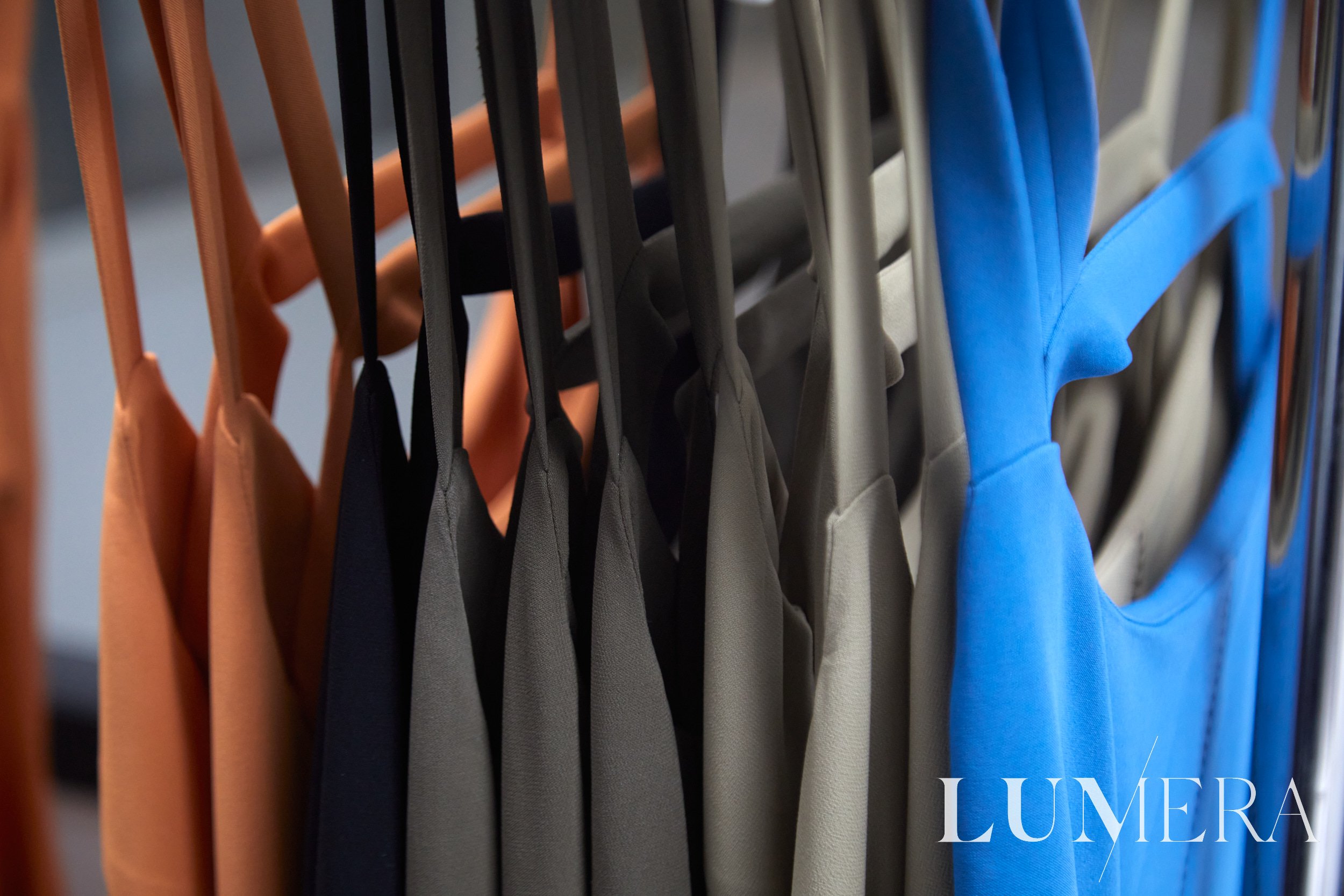
BUT IT CAN ALSO BE A CHALLENGE FOR YOUR CREATIVITY! LIKE WHEN YOU CAME UP WITH COMBINING LEATHER AND SILK.
Eloise: Exactly!
Emma: But it can also be frustrating. For example: We had the Amaya dress in all green, it was really beautiful, we had only two of them. They were sold out in three days. And we received direct messages from our clients almost every week about the availability of this dress. But we couldn’t do it again because, we didn’t have the fabric. It can be frustrating, because this dress is so beautiful. But it’s part of the game.
Eloise: Maybe next year we will find the fabric and we will produce it again, who knows!
Andrew: It’s a piece of art.
Emma: Exactly! The two clients who have the dress are the only two in the world. It’s almost like a piece of art!
DO YOU EVER DYE THE FABRICS? FOR EXAMPLE TO MATCH COLOR OF THE LEATHER TO THE SILK FOR THE AMAYA DRESS?
Eloise: No, never. But this makes me think about something! The other week, we were very happy to find a specific fabric. This is the leather we use for the Amaya dress, and we wanted to find the same color but in fake leather. It is very important to us to provide alternatives to some of our clients who don’t want to wear leather. Which I completely understand. And also for our new pieces we wanted to have some pvc leather. And look at this, it is the exact same color as the real leather! And it is a great quality, it is from one of the LVMH brands. Sometimes, we have great surprises like this. This was one of the moments when it felt like finding the needle in the haystack! It felt like finding a treasure!
AND THE PATTERN MAKING, DO YOU GUYS DO THAT IN HOUSE
Eloise: At the beginning Zelie did it, because she has a specialization for pattern making. The pants pattern for example are by her. But then we figured out that it is much easier and faster to do it out of house. We found someone with a lot of experience, he is over 40. He is so nice, so good, so talented. We want to work with him forever! And he works very nearby too.
AMAZING, SO YOU HAVE ONE PERSON FOR THE PATTERNS AND THE ATELIER IS SEPARATE.
Eloise: But they know each other! They work together a lot. But they’re different people.
AND YOU SAID YOU HAVE A BIG STOCK OF FABRICS. WHERE IS THAT?
Eloise: Yeah! Half of it is at the atelier de confection and the other half is over there! I have to show you!
YES, I CAN’T WAIT TO SEE IT! I HAVE ANOTHER QUESTION FOR YOU. YOU GUYS MET IN YOUR CHILDHOOD, WHERE EXACTLY DID YOU MEET?
Eloise: Emma and Zelie met first. When they were babies.
Emma: Our parents were best friends and we were almost born at the same time. We grew up like sisters. We were educated together, spend holidays together, we were always together. It’s different to my relationship with Eloise. But this is what works super well with Umlaut, the three of us have not the same relationship between us. Which is quite beautiful.
Eloise: I met Zelie at school when we were 11.
Emma: Zelie and Eloise were at the same school. And then I met Eloise because of Zelie.
Eloise: And it’s been the three of us since then.
WHAT DID YOU MEAN BY THE DIFFERENT KIND OF RELATIONSHIPS EXACTLY?
Emma: Zelie and me are like sisters. Eloise and Zelie’s are always calling each other, their relationship is about being childhood friends, it’s different. And Eloise and me have a caring, loving relationship, very close also, Zelie is in Biarritz now, so the two of us are together every day.
LET’S TALK ABOUT BIARRITZ! ZELIE’S FAMILY OWNS A CHATEAU THERE AND BOOK ROOMS FOR ARTISTS, ALMOST LIKE A HOTEL?
Eloise: Exactly, I don’t think they like the word hotel. In French we say pension de famille (engl. guesthouse), it’s an amazing place.
WHICH IS WHY YOU CHOSE IT FOR YOUR FIRST PHOTO SHOOT!
Eloise: Yes, it is just a magical place.
Emma: Within Umlaut we also show the relationship we have. It is really important to us to show people the places that influence our relationship and the brand. We want to show some places that we grew with, places in which our relationship and also the brand grew in. We are already going to Biarritz for more than 10 years, and since about 5 Zelie’s parents own Villa Magnan.
Eloise: We have a lot of memories there.
“IT IS REALLY IMPORTANT TO US TO SHOW PEOPLE THE PLACES THAT INFLUENCE OUR RELATIONSHIP AND THE BRAND. TO SHOW SOME PLACES THAT WE GREW WITH, AND THE RELATIONSHIP GREW WITH AND ALSO THE BRAND.”
Emma Panchot
AND YOU BOUGHT THE FABRICS THERE IN THE BEGINNING, IT REALLY IS A PLACE VERY INVOLVED IN YOUR BRAND. LET’S TALK ABOUT YOU GUY’S DIVIDING AND CONQUERRING – EACH OF YOU HAS AN AREA IN WHICH YOU CONTRIBUTE TO THE BRAND. WHO DOES WHAT?
Eloise: Zelie and me are doing the design. Zelie has a lot of technical knowledge within pattern making and I am responsible for styling and trends. Emma takes care of the visual communication and brand identity. But as we are a very young brand and the three of us are always together, we do everything together. So these are our official roles, but in the end there is a lot of collaboration.
Emma: Yeah, everything is done as a team. But the cool part is that we have our different specializations. There is some stuff, I really don’t know, sometimes the girls are talking to the atelier the confection and I just don’t understand a word! I don’t understand that vocabulary. And it is the same for them when I do my photography set or the graphic design.
Eloise: We really all learn from each other.
IT IS SUCH A GOOD EXAMPLE FOR TEAM WORK. IF YOU ARE WORKING TOGETHER, YOU CAN BUILD MORE. THIS IS ALSO WHY ANDREW AND ME STARTED TO WORK AS A TEAM, BECAUSE WE CAN JUST ACHIEVE SO MUCH MORE THAT WAY.
Andrew: It is really nice to have complimentary talents.
EXACTLY. AND YOU HAVE DIFFERENT VIEWPOINTS. DIFFERENT PERSPECTIVES. ANOTHER QUESTION: YOU SAID THAT THE STARTING POINT FOR THE DESIGN IS THE TEXTILES, HOW DOES THAT WORK?
Eloise: By now we can say that it depends on the product. Because we are evolving, we are searching for our method. We are launching a new dress, I don’t know when exactly, but as soon as possible. And for this dress, we first had the idea of the product. We knew we wanted some jersey but we didn’t start with the fabric. We started with an idea of the dress, did some sketches and stuff. But for the Amaya dress it was different, we found the leather and the silk and were inspired.
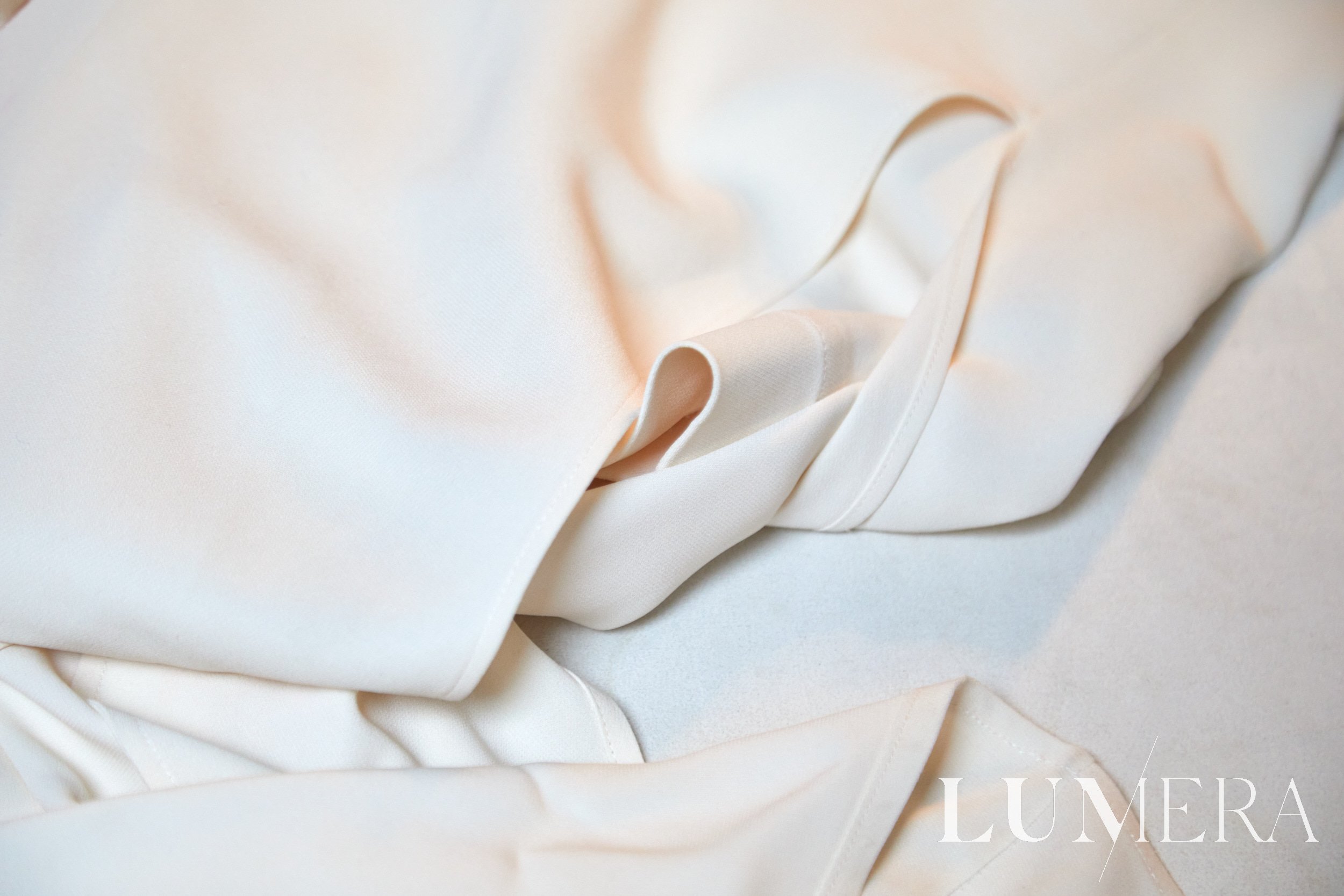
DO YOU HAVE A PERIOD OF TIME, AN ERA, A PERSON OR SOMETHING ELSE THAT INFLUENCES YOU VISUALLY? SOMETHING THAT YOU LOOK AT FOR INSPIRATION?
Eloise: It depends on the product again. But I feel that we have a major influence of the 90s since the beginning. But who knows, maybe tomorrow it will be the 70s. And again, the places we have been together are very influential to our art direction. The colors of villa Magnon for example. All that influences us, the places and people we know together.
IT IS A VERY PERSONAL BRAND, I REALLY LIKE THAT! IT’S REALLY A PROJECT FROM THE HEART. AND ONE CAN SEE THAT.
Emma: And we only produce new clothes if we want to. Only when we have an idea, when we feel something. When we feel inspired, then we produce. If we want to focus more on photography or other things, we do that. We are super free in the way we produce our products. We want to feel free and have our own rhythm.
“WE ONLY PRODUCE NEW CLOTHES IF WE WANT TO. ONLY WHEN WE HAVE AN IDEA, WHEN WE FEEL SOMETHING. WHEN WE FEEL INSPIRED, THEN WE PRODUCE.”
Emma Panchot
THAT’S HOW THE CREATIVITY STAYS ALIVE. BECAUSE IN MOST BIG COMPANIES THEY HAVE MANY COLLECTIONS A YEAR, IT’S REALLY ONE AFTER THE OTHER. AND YOU CAN’T BE CREATIVE LIKE THIS.
Eloise: And they all say that, all the biggest creators say that. At the end, it is not creation anymore, it is a consumption machine.
AND YOU CAN SEE THAT IN THE DESIGNS IF THERE IS NO LOVE BEHIND IT. YOU GUYS REALLY CREATE WITH PASSION. YOU DON’T DO COLLECTIONS, YOU DO DROPS, RIGHT?
Eloise: Exactly. A drop of a new dress or new colors. For example, we will have this new dress and new coats in maybe three weeks. They are the same coats as last winter but with different fabrics and different collars. And that changes really the product.
WHAT IS YOUR BESTSELLER?
Emma: The Amaya dress. Especially with the original colors.
I READ THAT YOU’RE THINKING TO EXPAND TO ACCESSORIES, IS THAT IDEA STILL ON THE TABLE?
Emma: I am completely obsessed by the idea of creating a bag.
Eloise: We had some sketches of ideas!
Emma: And swimsuits, it’s not really an accessory, but I’d love to do swimsuits as well! But there is nothing official yet.
Andrew: So, the swimsuits on the images here are not your designs?
Eloise: No, it was an editorial shoot with the Amaya and the Lara dress.
THE GARMENTS ARE NAMED AFTER YOUR FRIENDS, AREN’T THEY?
Emma: After the models who wear the dress on the shoot!
Eloise: But Amaya is also a friend from Biarritz. And Lara was our model, we loved her, so we named the dress after her. And for the coat, it is actually the name of the pattern maker! His name is Dorin, so it’s the Dorin coat!
“LARA WAS OUR MODEL, WE LOVED HER, SO WE NAMED THE DRESS AFTER HER.”
Eloise Bombeau
THE LAST QUESTION I ASK EVERYONE I INTERVIEW. WITH MY MAGAZINE I WANT TO SHINE A LIGHT ON PEOPLE OF THE INDUSTRY WHO DO A POSITIVE CHANGE. IF YOU COULD SHINE A LIGHT ON SOMETHING WITHIN THE FASHION INDUSTRY, WHAT WOULD IT BE?
Eloise: There is so much!
Emma: The Ere Foundation. They try to find young, creative people within photography, fashion and art who want to make the world better, who want to make politics better, very different subjects. It is really nice. We have some friends who work in this place. I think they have a good vision and the people they work with are really interesting.
Eloise: Actually, right now they are raising some money for the women in Afghanistan. They are doing some exhibitions in different galleries with photographers from all over the world who took pictures of Afghanistan. It’s wonderful images. You can buy the prints and support women in Afghanistan with your purchase.
Emma: But there are a lot of different subjects. For example, there is Imruh, a stylist who works just downstairs and he did something with them. He took clothes that people threw out in clothing containers and did some absolutely incredible sculptures with all those clothes. It’s really nice, they raise awareness on all these different topics, like women in Afghanistan, the waste issues in fashion, really different subjects. Each time it’s a very interesting point of view.
THAT’S AMAZING! I WILL LOOK THEM UP! THANK YOU SO MUCH FOR YOUR TIME AND ALL THESE INTERESTING ANSWERS! WE LEARNED A LOT!
Eloise: Thank you so much for coming by! It was a real pleasure! The questions were very different from other interviews we did before!
Emma: Thank you!
VF
LA MARQUE DE MODE PARISIENNE UMLAUT - C'EST ELOISE, ZELIE ET EMMA. TOUTES LES TROIS SE CONNAISSENT DEPUIS L'ENFANCE ET ONT DÉCIDÉ IL Y A DEUX ANS DE CONTRIBUER À CHANGER L'INDUSTRIE DE LA MODE. D'OÙ LE NOM - UMLAUT. IL S'AGIT DU SYMBOLE PHONÉTIQUE ALLEMAND QUI MODIFIE UNE VOYELLE D'UN A EN Ä OU D'UN U EN Ü. COMME LE TRÉMA SUR LES LETTRES, LES FILLES MODIFIENT LA CHAÎNE D'APPROVISIONNEMENT DANS LE SECTEUR DE LA MODE. COMMENT ? DÉCOUVREZ-LE DANS NOTRE INTERVIEW, ANDREW ET MOI LEUR AVONS RENDU VISITE DANS LEUR STUDIO DU 10E ARRONDISSEMENT. LEUR BUREAU EST SITUÉ AU DERNIER ÉTAGE D'UN IMMEUBLE DE TRAVAIL PARTAGÉ POUR LES ARTISTES. PLUSIEURS CRÉATIFS RÉSERVENT DES STUDIOS ICI ET S'ENTRAIDENT QUAND ILS LE PEUVENT. UNE FOIS ARRIVÉS AU TROISIÈME ÉTAGE, NOUS AVONS ÉTÉ ACCUEILLIS PAR DES ÉTAGÈRES DE ROBES, DE HAUTS ET DE PANTALONS UMLAUT, TOUS CLASSÉS PAR COULEUR. LEURS CAMPAGNES DÉCORENT LES MURS ET, DE L'AUTRE CÔTÉ DU HALL, UNE AUTRE JEUNE MARQUE EST EN PLEINE SÉANCE DE PHOTOS.
textes de SARAH MARIE FRANKEN photographies d'ANDREW DAY
VOUS AVEZ CHOISI LE NOM UMLAUT PARCE QUE VOUS VOULEZ CHANGER L'INDUSTRIE DE LA MODE. QUELLE EST VOTRE VISION IDÉALE DE L'AVENIR DE LA MODE ?
Emma : Dans un premier temps, au cours des prochaines années, il s'agirait d'une utilisation accrue de l'upcycling. Il y a beaucoup de tissus qui sont fabriqués mais jamais utilisés. Dans un deuxième temps, il y a le sujet de l'innovation textile. Comment pouvons-nous créer davantage de tissus fabriqués de manière écologique ? Ce serait bien de créer de nouveaux matériaux grâce à l'innovation et à l'ingénierie !
J'ADORE ÇA, L'INNOVATION ET L'UTILISATION DE CE QUE NOUS AVONS DÉJÀ. ET C'EST EXACTEMENT CE QUE VOUS FAITES AVEC VOTRE MARQUE. VOUS CONCENTREZ-VOUS EXCLUSIVEMENT SUR L'UPCYCLING DE TISSUS DE HAUTE COUTURE OU INCLUEZ VOUS LES RESTES DE TISSUS EN GÉNÉRAL ?
Eloïse : Je pense que pour 90%, ce sont des tissus de haute couture des plus grandes maisons de luxe de Paris comme Givenchy, Louis Vuitton ou Sonia Rykiel.
Emma : Mais ils ne produisent pas les tissus, ils se procurent leurs tissus auprès de fabricants japonais ou italiens principalement.
EXACTEMENT, ET ENSUITE CE QUI SE PASSE C'EST QU'ILS APPORTENT CE QU'ILS N'UTILISENT PAS DANS LES MAGASINS OÙ VOUS LES ACHETEZ ?
Eloïse : Exact, on les récupère soit auprès de magasins, soit auprès d'associations qui les mettent aux enchères, soit auprès de start-ups.
Emma : Il y a quelques semaines par exemple, nous avons commencé à travailler avec une start-up. Il s'agit d'un type qui a travaillé pour LVMH pendant de nombreuses années et qui est en train de monter cette incroyable start-up, où il collecte les tissus de toutes les marques de LVMH qui ne sont pas utilisés. Et il les vend à des prix raisonnables à des petites marques comme nous qui n'ont pas un gros budget. C'est génial. Il y a en fait pas mal de start-ups qui font ça maintenant.
COMMENT SE DÉROULE LE PROCESSUS D'ACHAT POUR VOUS ? OÙ ALLEZ-VOUS PHYSIQUEMENT ?
Eloïse : (rires) Nous allons partout ! Nous devons acheter beaucoup de tissus, comme vous pouvez le voir. Ce sont tous les tissus que nous avons achetés pour notre nouvelle production. Nous devons avoir un grand stock car nous ne pouvons pas choisir la couleur exacte des tissus, tout est déjà fait. Nous devons donc disposer d'un stock important de différentes options. Nous allons vraiment dans beaucoup d'endroits pour trouver des tissus. On a souvent l'impression de trouver une aiguille dans une botte de foin.
Emma : C'est amusant parce que nous rencontrons toujours de nouvelles personnes ou découvrons de nouveaux endroits qui vendent des restes de tissus. C'est un processus très amusant de les trouver !
"NOUS DEVONS AVOIR UN GRAND STOCK DE DIFFÉRENTES OPTIONS. NOUS ALLONS VRAIMENT DANS BEAUCOUP D'ENDROITS POUR TROUVER DES TISSUS. ON A SOUVENT L'IMPRESSION DE TROUVER L'AIGUILLE DANS LA BOTTE DE FOIN."
Eloïse Bombeau
JE PEUX L'IMAGINER ! ET POUR LA CHASSE AUX TISSUS, VOUS ALLEZ TOUS ENSEMBLE ET VOUS EN FAITES UNE JOURNÉE ?
Eloïse : Oui ! On appelle ça nos journées de sourcing ! Nous nous rendons tous ensemble dans différents arrondissements de Paris à la recherche de tel ou tel jersey ou de telle ou telle couleur de soie. C'est la mission de la journée de trouver exactement cela.
DANS QUEL ARRONDISSEMENT TROUVEZ-VOUS LE PLUS ?
Souvent dans le 3e arrondissement, parfois en banlieue, ou dans le 10e - ça change tout le temps.
ET J'AI LU QUE VOUS FRÉQUENTIEZ AUSSI LES MARCHÉS AUX PUCES !
Eloïse : On en a fait beaucoup au début ! Pour les nouvelles pièces, on le fait moins. Quand nous y allons, c'est dans ce super marché aux puces à Biarritz, dans le sud de la France. On a réussi à trouver de la belle soie avec de beaux motifs là-bas !
Emma : Mais c'était vraiment au début, car on ne peut trouver que de petites quantités, 3 mètres maximum ! Et avec ça, on ne peut faire qu'une seule robe. Alors maintenant, ce n'est plus possible (rires). Malheureusement, il nous en faut plus !
COMMENT TROUVEZ-VOUS LES START-UPS ? LES TROUVEZ-VOUS SUR INTERNET ?
Emma : C'est plutôt du bouche-à-oreille. Soit les gens parlent de nous, soit nous parlons aux gens de ce que nous recherchons. C'est plutôt dans le cadre des contacts que nous avons à Paris.
J'AI LU QUE VOUS PENSIEZ VOUS ÉTENDRE AUX ACCESSOIRES, CETTE IDÉE EST-ELLE TOUJOURS D'ACTUALITÉ ?
Emma : Je suis complètement obsédée par l'idée de créer un sac.
Eloïse : Nous avons eu quelques ébauches d'idées !
Emma : Et des maillots de bain, ce n'est pas vraiment un accessoire, mais j'adorerais faire des maillots de bain aussi ! Mais il n'y a encore rien d'officiel.
Andrew : Donc, les maillots de bain sur les images ici ne sont pas vos créations ?
Eloïse : Non, c'était un shooting éditorial avec la robe Amaya et la robe Lara.
LES VÊTEMENTS PORTENT LE NOM DE VOS AMIS, N'EST-CE PAS ?
Emma : Du nom des mannequins qui portent la robe sur le tournage !
Eloïse : Mais Amaya est aussi une amie de Biarritz. Et Lara était notre mannequin, on l'adorait, donc on a donné son nom à la robe. Et pour le manteau, c'est en fait le nom du modéliste ! Son nom est Dorin, donc c'est le manteau Dorin !
"LARA ÉTAIT NOTRE MODÈLE, NOUS L'AIMIONS, ALORS NOUS AVONS DONNÉ SON NOM À LA ROBE".
Eloise Bombeau
LA DERNIÈRE QUESTION QUE JE POSE À TOUS CEUX QUE J'INTERVIEWE. AVEC MON MAGAZINE, JE VEUX METTRE EN LUMIÈRE LES PERSONNES DE L'INDUSTRIE QUI FONT UN CHANGEMENT POSITIF. SI VOUS POUVIEZ METTRE EN LUMIÈRE QUELQUE CHOSE DANS LE SECTEUR DE LA MODE, QU'EST-CE QUE CE SERAIT ?
Eloïse : Il y en a tellement !
Emma : La Fondation Ere. Ils essaient de trouver des jeunes gens créatifs dans le domaine de la photographie, de la mode et de l'art qui veulent rendre le monde meilleur, qui veulent rendre la politique meilleure, des sujets très différents. C'est vraiment bien. Nous avons quelques amis qui travaillent dans cet endroit. Je pense qu'ils ont une bonne vision et les personnes avec qui ils travaillent sont vraiment intéressantes.
Eloïse : En ce moment, ils collectent de l'argent pour les femmes en Afghanistan. Ils font des expositions dans différentes galeries avec des photographes du monde entier qui ont pris des photos de l'Afghanistan. Ce sont des images magnifiques. Vous pouvez acheter les tirages et soutenir les femmes en Afghanistan avec votre achat.
Emma : Mais il y a beaucoup de sujets différents. Par exemple, il y a Imruh, un styliste qui travaille juste en bas et il a fait quelque chose avec eux. Il a pris des vêtements que les gens jetaient dans des conteneurs et a fait des sculptures absolument incroyables avec tous ces vêtements. C'est vraiment bien, ils sensibilisent les gens à toutes sortes de sujets, comme les femmes en Afghanistan, les problèmes de déchets dans la mode, des sujets vraiment différents. Chaque fois, c'est un point de vue très intéressant.
C'EST GÉNIAL ! JE VAIS LES CONSULTER ! MERCI BEAUCOUP POUR VOTRE TEMPS ET POUR TOUTES CES RÉPONSES INTÉRESSANTES ! NOUS AVONS BEAUCOUP APPRIS !
Eloïse : Merci beaucoup d'être venu ! C'était un vrai plaisir ! Les questions étaient très différentes des autres interviews que nous avons faites auparavant !
Emma : Merci !

